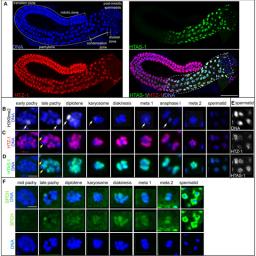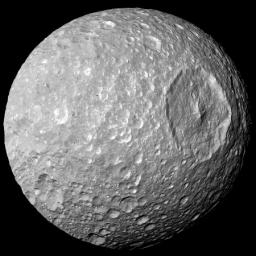
Following up on last week's
article about offspring and mothers' previous sexual partners (in insects, anyway), new research now sheds some additional light on the multi-layered process of how a sperm and egg pass along information needed for successful reproduction.
As described in an article published in the journal PLOS Genetics:
Though one layer is the DNA code that is transferred, the new study identifies information not encoded by DNA, a so-called "epigenetic" layer of information that helps the cell interpret the genetic code.
In insects this additional "epigenetic" layer of information apparently can come from a previous mate. The question if such or similar mechanisms can also exist in higher organisms, e.g. also in humans, might be far fetched, but not that far, that it precludes a more thorough research. Clearly, there are still plenty of unknown factors in human and non-human reproduction: an area ripe for further research.

Mimas, one of Saturn's smaller satellites, may seem a little dull... An icy moon that's just 246 miles wide and whose most distinctive feature is the 88-mile-wide Herschel crater - a giant Cyclops-like indentation that makes the moon resemble the planet-obliterating superweapon from "Star Wars" that's known as the Death Star. But the moon
may hold a special secret of its own. A stronger than expected rotational wobble points to one of two intriguing scenarios: Mimas either has an irregularly shaped core or has an ocean buried underneath its icy surface. "Something else has to be going on inside." The findings, described in the journal Science, shed new light on a mysterious but often-overlooked moon that could hold clues to its early formation.
Other scientists say it's unlikely Mimas has such an interesting interior and think
the wobble can be explained more simply. One problem is that Mimas's ancient, heavily cratered surface shows no signs that water has ever touched it-unlike, say, the freshly Zamboni-ed ice skating rink of Europa. That same result could be achieved with irregular gradations in the density of rock, ice, and pore space. The detected wobble could also have been knocked into existence by something that has nothing to do with the moon's interior: a comet impact.
 Following up on last week's article about offspring and mothers' previous sexual partners (in insects, anyway), new research now sheds some additional light on the multi-layered process of how a sperm and egg pass along information needed for successful reproduction.
Following up on last week's article about offspring and mothers' previous sexual partners (in insects, anyway), new research now sheds some additional light on the multi-layered process of how a sperm and egg pass along information needed for successful reproduction.